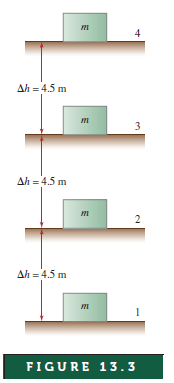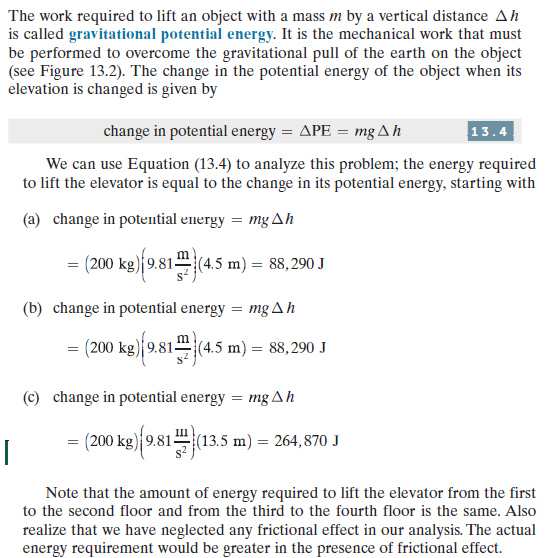4 Ah = 4.5 m Ah = 4.5 m 2 Ah = 4.5 m FIGURE 1 3.3 The work required to lift an object with a mass m by a vertical distance Ah is called gravitational potential energy. It is the mechanical work that must be performed to overcome the gravitational pull of the earth on the object (see Figure 13.2). The change in the potential energy of the object when its elevation is changed is given by change in potential energy = APE = mg Ah 13.4 We can use Equation (13.4) to analyze this problem; the energy required to lift the elevator is equal to the change in its potential energy, starting with (a) change in potential energy = mg Ah = (200 kg) 9.81(4.5 m) = 88,290 J (b) change in potential energy = mg Ah = (200 kg)|9.81 (4.5 m) = 88,290 J (c) change in potential energy = mg Ah (200 kg) 9.81(13.5 m) = 264, 870 J Note that the amount of energy required to lift the elevator from the first to the second floor and from the third to the fourth floor is the same. Also realize that we have neglected any frictional effect in our analysis. The actual energy requirement would be greater in the presence of frictional effect.
4 Ah = 4.5 m Ah = 4.5 m 2 Ah = 4.5 m FIGURE 1 3.3 The work required to lift an object with a mass m by a vertical distance Ah is called gravitational potential energy. It is the mechanical work that must be performed to overcome the gravitational pull of the earth on the object (see Figure 13.2). The change in the potential energy of the object when its elevation is changed is given by change in potential energy = APE = mg Ah 13.4 We can use Equation (13.4) to analyze this problem; the energy required to lift the elevator is equal to the change in its potential energy, starting with (a) change in potential energy = mg Ah = (200 kg) 9.81(4.5 m) = 88,290 J (b) change in potential energy = mg Ah = (200 kg)|9.81 (4.5 m) = 88,290 J (c) change in potential energy = mg Ah (200 kg) 9.81(13.5 m) = 264, 870 J Note that the amount of energy required to lift the elevator from the first to the second floor and from the third to the fourth floor is the same. Also realize that we have neglected any frictional effect in our analysis. The actual energy requirement would be greater in the presence of frictional effect.
Chapter2: Loads On Structures
Section: Chapter Questions
Problem 1P
Related questions
Question
Calculate the energy required to lift an elevator and its occupants with a
mass of 2000 kg for the following situations: (a) between the first and the
second floor, (b) between the third and the fourth floor, (c) between the first
and the fourth floor. (as shown .) The vertical distance between each
floor is 4.5 m. We can use as shown to analyze this problem; the energy required to lift the elevator is equal to the change in its potential energy, starting with

Transcribed Image Text:4
Ah = 4.5 m
Ah = 4.5 m
2
Ah = 4.5 m
FIGURE 1 3.3

Transcribed Image Text:The work required to lift an object with a mass m by a vertical distance Ah
is called gravitational potential energy. It is the mechanical work that must
be performed to overcome the gravitational pull of the earth on the object
(see Figure 13.2). The change in the potential energy of the object when its
elevation is changed is given by
change in potential energy = APE = mg Ah
13.4
We can use Equation (13.4) to analyze this problem; the energy required
to lift the elevator is equal to the change in its potential energy, starting with
(a) change in potential energy = mg Ah
= (200 kg) 9.81(4.5 m) = 88,290 J
(b) change in potential energy = mg Ah
= (200 kg)|9.81 (4.5 m) = 88,290 J
(c) change in potential energy = mg Ah
(200 kg) 9.81(13.5 m) = 264, 870 J
Note that the amount of energy required to lift the elevator from the first
to the second floor and from the third to the fourth floor is the same. Also
realize that we have neglected any frictional effect in our analysis. The actual
energy requirement would be greater in the presence of frictional effect.
Expert Solution
This question has been solved!
Explore an expertly crafted, step-by-step solution for a thorough understanding of key concepts.
Step by step
Solved in 4 steps

Knowledge Booster
Learn more about
Need a deep-dive on the concept behind this application? Look no further. Learn more about this topic, civil-engineering and related others by exploring similar questions and additional content below.Recommended textbooks for you


Structural Analysis (10th Edition)
Civil Engineering
ISBN:
9780134610672
Author:
Russell C. Hibbeler
Publisher:
PEARSON

Principles of Foundation Engineering (MindTap Cou…
Civil Engineering
ISBN:
9781337705028
Author:
Braja M. Das, Nagaratnam Sivakugan
Publisher:
Cengage Learning


Structural Analysis (10th Edition)
Civil Engineering
ISBN:
9780134610672
Author:
Russell C. Hibbeler
Publisher:
PEARSON

Principles of Foundation Engineering (MindTap Cou…
Civil Engineering
ISBN:
9781337705028
Author:
Braja M. Das, Nagaratnam Sivakugan
Publisher:
Cengage Learning

Fundamentals of Structural Analysis
Civil Engineering
ISBN:
9780073398006
Author:
Kenneth M. Leet Emeritus, Chia-Ming Uang, Joel Lanning
Publisher:
McGraw-Hill Education


Traffic and Highway Engineering
Civil Engineering
ISBN:
9781305156241
Author:
Garber, Nicholas J.
Publisher:
Cengage Learning